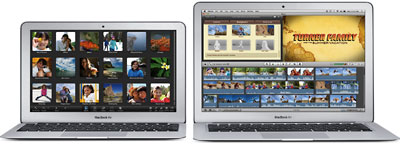The original MacBook
Air notebook came out in 2008. Many found its lightweight, slim
design intriguing - remember ads showing it being slipped inside a
manila envelope? But I suspect more potential buyers were put off by
its low power, lack of features (no optical drive, no network port,
only one USB port), and high price, initially ranging from $1,799 to
$3,099.
Instead, the following year, more buyers looking for portability
picked up a netbook - lightweight, low-powered, and with a sub-$500
price point. Apple's Steve Jobs' response was that Apple didn't "know
how to build a sub-$500 computer that is not a piece of junk."
The New Generation
Late in 2010, the company released a pair of new MacBook Air models,
which Jobs claimed would "change the way we think about notebooks." He
suggested the company was bringing features from the popular iPad
tablets to more traditional notebook design: lightweight construction,
instant on, strong battery life.
 The new models come in two sizes,
with a 13.3" screen
(similar to the original Air) and a new 11.6" screen. Both offer
denser screen resolutions than other Apple notebooks that allow the 11"
model to pack 1366 x 768 pixels - more than most 13" notebooks.
The new models come in two sizes,
with a 13.3" screen
(similar to the original Air) and a new 11.6" screen. Both offer
denser screen resolutions than other Apple notebooks that allow the 11"
model to pack 1366 x 768 pixels - more than most 13" notebooks.
Apple loaned me that model for several weeks.
While built around an older-generation processor running at a fairly
slow speed (1.4 GHz on my loaner 11" system), I was pleasantly
surprised at how quick and responsive it felt. Boot time and
application startup times were quicker than on my own Mac laptop
(despite its faster CPU). That's partly because by choosing Intel's
older Core 2 Duo processor, Apple was able to build in fast Nvidia
graphics. And while fast solid-state drives were an expensive option on
the old MacBook Airs, they're built into all of the new models.
That relatively slow processor is also more energy efficient, and
the solid-state drive takes up less space than a traditional hard
drive, leaving more room for a larger battery. The result: up to five
hours of battery life in the 11" model and up to seven in the 13"
model.
Almost Instant On
The promised instant startup is true - sort of. The solid-state
drive allows for fast - but not instant - boot up. Close the lid and,
like many other notebooks, it goes to sleep. Unlike many other models,
open the lid and it almost instantly comes back to life. Apple promises
that it can awaken after as long as 30 days asleep.
The original MacBook Airs were clearly high-priced luxury items.
That's no longer as true. Pricing starts at $999 for the 11" model, the
same price point as Apple's low-end white, plastic MacBook
model.
Unchanged: still no built-in network adaptor or optical drive,
though both can be added as external plugins. That's made easier by now
having two USB ports. (The 13" model also adds a slot for a
camera-style SD memory card.)
iPad vs. MacBook Air
Is the 11" MacBook Air competition for Apple's iPad tablet? That depends. iPad pricing
starts at $499, but an iPad with the same size (64 GB) solid-state
storage can cost up to $829.
That model iPad is a bit lighter, smaller, and cheaper than the
MacBook Air. It's also arguably better for reading ebooks and watching
videos. And that $829 model has built-in 3G wireless, making it always
connected online, while the MacBook Air's connectivity is limited to
nearby WiFi hotspots.
On the other hand, the iPad is essentially an oversized smartphone
running scaled-down apps, while the MacBook Air - though light and
portable - is a full-fledged notebook computer, running standard
productivity applications, connecting to standard peripherals, and
printing without any issues.
Just don't let Apple hear you calling it a netbook.

First published in Business in Vancouver January 18-24, 2011 issue
#1108.

 The new models come in two sizes,
with a
The new models come in two sizes,
with a 
